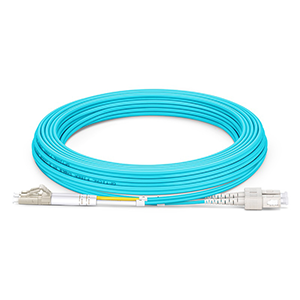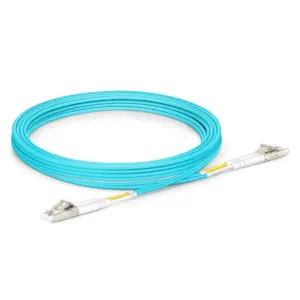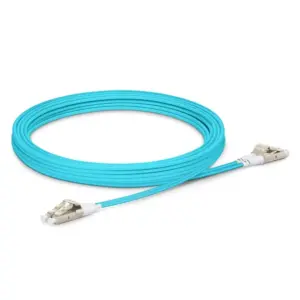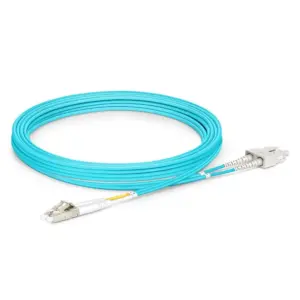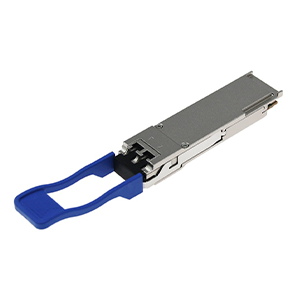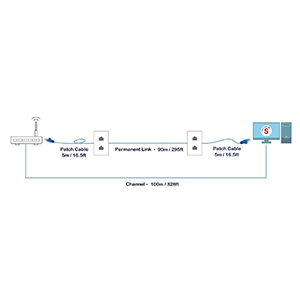In today’s article, I will introduce you to OM3 fiber as an important member of multimode fiber. We will explore the characteristics and wide range of applications of OM3 optical fiber. As an excellent fiber optic solution, OM3 fiber has excellent transmission performance. Let’s learn more about OM3 optical fiber together!
Basic knowledge of OM3 optical fiber
OM3 optical fiber is a multi-mode optical fiber with specific definitions, characteristics and technical indicators. The following is the basic knowledge about OM3 optical fiber:
Definition and characteristics:
- OM3 optical fiber definition: OM3 is one of the multi-mode optical fiber specifications developed by ITU-T (Telecommunications Standardization Sector of the International Telecommunications Union) and TIA (Telecommunications Industry Association). It is a 50/125 micron (core diameter 50 micron, cladding diameter 125 micron) fiber type.
- Features:
- High bandwidth: OM3 optical fiber supports high-bandwidth transmission and can be used in application scenarios such as Fast Ethernet (such as Gigabit Ethernet and 10 Gigabit Ethernet).
- Medium transmission distance: The transmission distance of OM3 fiber is longer than that of OM1 and OM2 fiber, and it is suitable for medium-distance data transmission needs.
- Low loss: OM3 optical fiber has low transmission loss and can achieve high-quality signal transmission.
Differences from other multimode optical fibers:
- OM3 vs. OM1 and OM2: Compared with OM1 and OM2 optical fibers, OM3 optical fibers have higher bandwidth and longer transmission distance. OM1 and OM2 optical fibers are generally used for shorter distance transmission, while OM3 optical fiber is suitable for medium-distance high-bandwidth transmission requirements.
- OM3 vs. OM4 and OM5: OM3 optical fiber has slightly lower bandwidth and transmission distance than OM4 and OM5 optical fiber. OM4 and OM5 optical fibers support higher bandwidth and longer transmission distances, making them suitable for higher-speed network applications.
Transmission performance and technical indicators:
- Bandwidth: The bandwidth of OM3 fiber is 2000 MHz·km, which represents the highest frequency signal that the fiber can transmit under the conditions of a specific light source and receiver.
- Transmission distance: The transmission distance of OM3 optical fiber depends on the light source used and the transmission rate. In the case of Gigabit Ethernet (1000BASE-SX), the transmission distance of OM3 fiber is up to 300 meters; in the case of 10 Gigabit Ethernet (10GBASE-SR), the transmission distance is 33 meters.
- Loss: The transmission loss of OM3 optical fiber is low, usually below 3.5 dB/km, which means that during the signal transmission process, the attenuation of the optical signal is smaller and longer transmission distances can be achieved.
In short, OM3 fiber is a 50/125 micron multi-mode fiber with the characteristics of high bandwidth, medium transmission distance and low loss. Compared with other multi-mode optical fibers (such as OM1, OM2, OM4 and OM5), it is different in terms of bandwidth, transmission distance and transmission performance.
What are the advantages of OM3 optical fiber
OM3 optical fiber has the following advantages in high-speed data transmission:
-
High bandwidth: OM3 optical fiber has high bandwidth characteristics, with a bandwidth of 2000 MHz·km. This enables OM3 fiber to support high-speed data transmission, such as Gigabit Ethernet (1 Gbps) and 10 Gigabit Ethernet (10 Gbps) applications. High bandwidth means that optical fiber can transmit more data at the same time, thus meeting the needs of large-capacity data transmission.
-
Low loss: OM3 optical fiber has the characteristics of low transmission loss. Its transmission loss is generally less than 3.5 dB/km. Low loss means that during signal transmission, the attenuation of the optical signal is smaller and longer transmission distances can be achieved. This is very important for long-distance or large-scale data centers and enterprise networks to ensure reliable transmission of signals.
-
High-speed data transmission: Due to the high bandwidth and low loss characteristics of OM3 optical fiber, it has advantages in high-speed data transmission. In data centers and enterprise networks, more and more applications require high bandwidth and fast data transmission, such as data storage, cloud computing, virtualization and high-definition video transmission. OM3 optical fiber can meet these needs, support high-speed, large-capacity data transmission, and ensure the efficient operation of data centers and enterprise networks.
-
Scalability and compatibility: OM3 fiber is a standardized fiber specification that is compatible with other fiber types such as OM1, OM2, OM4 and OM5. This means OM3 fiber can be deployed on existing fiber infrastructure without replacing the entire network infrastructure. In addition, OM3 optical fiber also has good scalability and can support higher-speed optical fiber transmission technology in the future.
So OM3 optical fiber has the advantages of high bandwidth, low loss, high-speed transmission and compatibility in high-speed data transmission. This makes it a commonly used optical fiber choice in data centers and enterprise networks, capable of meeting large-capacity, high-efficiency data transmission needs and adapting to the development of future network technology.
Application fields of OM3 optical fiber
OM3 optical fiber is widely used in different fields. The following are some typical application cases:
-
Data center: Data center is the core of large-scale data storage and processing, requiring high-bandwidth and low-latency network connections. OM3 optical fiber is used to connect servers, storage devices and network switches within data centers, supporting fast data transmission and efficient data processing. It can meet the high-density connection requirements within the data center and achieve rapid data exchange and distribution.
-
Campus network: The campus network covers a wide range and connects various teaching buildings, libraries, laboratories, student dormitories and other places. OM3 optical fiber is used in campus networks to establish high-speed local area networks (LAN) and backbone networks, supporting a large number of users to access the Internet, online learning, multimedia teaching and other applications at the same time. It can meet the campus network’s requirements for high bandwidth, long transmission distance and reliability.
-
Telecommunications industry: In the telecommunications industry, OM3 optical fiber is widely used in optical fiber communication networks. It is used to build optical fiber backbone networks, optical fiber access networks and fiber-to-the-home networks to provide users with high-speed broadband access and various communication services, such as Internet access, video communications and mobile communications. The high bandwidth and low loss characteristics of OM3 fiber make it the preferred fiber choice for telecom operators.
Practical application cases:
- In a large data center, OM3 optical fiber is used to connect hundreds of servers and storage devices to achieve high-speed data transmission and distributed computing.
- In a university campus network, OM3 fiber is used to establish high-speed LAN and backbone networks to support high-bandwidth Internet access and online teaching for students and faculty.
- A telecom operator uses OM3 optical fiber in the optical fiber access network to provide users with high-speed broadband access and high-definition video on demand services.
These cases highlight the importance of OM3 optical fiber in data centers, campus networks and telecommunications industries. Its high bandwidth, low loss and reliability make it ideal for meeting high-capacity, high-rate data transmission needs. Whether in large-scale data processing, educational institution networks or communications service providers, OM3 optical fiber plays a key role in enabling fast, reliable and efficient data transmission.
How to deploy and configure OM3 optical fiber
Deploying an OM3 optical network involves the following key steps:
-
Design planning: First, network design planning is required to determine the optical fiber cabling path, connection points, and equipment locations. This includes determining fiber lengths, connector types and topologies to meet network needs.
-
Optical cable laying: After the planning is completed, lay the optical cable. Fiber optic cables can be buried, aerial, or installed in conduits, depending on site conditions and network needs. Keep fiber optic cables safe and protected from damage and bends.
-
Fiber optic connector installation: OM3 fiber uses different types of connectors, such as LC, SC, ST, etc. According to actual needs, select the appropriate connector and install the connector. Correct installation of connectors is critical to ensuring the transmission quality of optical signals.
-
Fiber end processing: After the connector is installed, the fiber end needs to be processed, including cutting, refraction and cleaning. Make sure the end of the fiber is flat, smooth, and clear of any contaminants to ensure the quality of the optical signal transmission.
-
Testing and verification: After completing the deployment of the fiber optic network, perform testing and verification. Use fiber optic testing instruments to measure fiber optic links and check parameters such as signal quality, transmission loss, and bandwidth to ensure the normal operation of the network.
When selecting connectors and accessories for OM3 optical fiber, the following factors should be considered:
-
Connector type: OM3 fiber can use a variety of connector types, such as LC, SC, ST, MPO, etc. When selecting a connector, consider the interface type and compatibility of your network device.
-
Accessories and adapters: Depending on actual needs, accessories such as adapters, jumpers, and compensators may be used to adapt the connector and extend the length of the optical cable.
-
Quality and reliability: Choose connectors and accessories with reliable quality to ensure the stability of the connection and the transmission quality of the optical signal. Reference may be made to the supplier’s product certifications and technical specifications.
OM3 fiber has good compatibility and interoperability, it is compatible with other types of fiber. This means OM3 fiber can be deployed on existing fiber infrastructure without replacing the entire network. In addition, OM3 optical fiber is also compatible with various network equipment and optical fiber transmission systems, and can be interconnected with other types of optical fibers. This compatibility and interoperability make OM3 optical fiber a flexible and reliable optical fiber solution suitable for different network environments and application scenarios.
Summary
Thank you for reading our blog! Through the discussion in this article, you will have a deeper understanding of OM3 optical fiber as an important member of multimode optical fiber. OM3 optical fiber is widely used in various fields due to its excellent transmission performance. By choosing our OM3 fiber optic products, you will receive a solution of high quality, reliability and performance. Our team is here to provide you with professional support for your fiber optic network needs.
OM3 Fiber FAQ
OM3 fiber is optimized for use with 850nm vertical-cavity surface-emitting lasers (VCSELs) and supports transmission rates of up to 10 Gigabits per second (Gbps) over link distances of up to 300 meters.
OM3 fiber is a multimode fiber, whereas single-mode fiber is designed for transmission of a single optical mode. Single-mode fiber typically supports longer distances and higher bandwidth compared to OM3 fiber.
OM3 fiber is commonly used in data centers, local area networks (LANs), and other high-speed networking applications. It is suitable for short to medium distance transmissions, such as interconnecting switches, routers, and servers.
Yes, OM3 fiber is backward compatible with older multimode fibers like OM1 and OM2. It can be used in conjunction with these fibers within the same network infrastructure, allowing for seamless upgrades and expansions.
OM3 fiber typically uses the same connectors as other multimode fibers, such as the LC, SC, and ST connectors. These connectors provide reliable and efficient connections for OM3 fiber installations.
OM3 fiber can support link distances of up to 300 meters for 10 Gigabit Ethernet (10GBASE-SR) transmissions using VCSEL-based optical transceivers. For lower data rates, such as 1 Gigabit Ethernet (1000BASE-SX), OM3 fiber can support longer link distances.
While OM3 fiber is primarily designed for 10 Gigabit Ethernet applications, it can also support higher data rates, such as 40 Gigabit Ethernet and 100 Gigabit Ethernet, using parallel transmission schemes and multiple fibers.
OM3 fiber is primarily intended for short to medium distance transmissions within data centers and LAN environments. For long-distance transmissions, single-mode fiber is typically a more suitable option.
Yes, OM3 fiber is widely available in the market as it has been a popular choice for high-speed data transmission in data centers and LAN applications. It can be obtained from various fiber optic cable manufacturers and suppliers.

